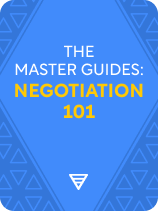

This article is an excerpt from the Shortform book guide to "The Master Guides: Negotiation" by Shortform. Shortform has the world's best summaries and analyses of books you should be reading.
Like this article? Sign up for a free trial here.
What are the best ways to prepare to negotiate? What factors should you consider before entering a negotiation?
Experts agree that preparing to negotiate is essential. We’ll cover the main ways to prepare for a successful negotiation—by preparing for the worst, planning your moves and countermoves in advance, determining your boundaries for the negotiation, and understanding what kind of negotiator you’re going up against.
Take your negotiation preparation tactics to the next level below.
1. Prepare First—and Plan for the Worst
Fisher and Ury (Getting to Yes) write that preparation is the first step in any negotiation. Since you won’t know what the other side’s strategy is going to be, it’s best to focus on preparation initially and decide your direction of argument later.
They recommend some tactics for preparing to negotiate:
- Think about the end: Before starting to negotiate, think about what a good agreement would look like. To get there, what issues would have to be resolved? What kind of agreement could both you and your counterpart justify to yourselves? Envisioning the end result will help you stay on track.
- Draft a framework agreement. Create a document that outlines a potential agreement with spaces for each item to be resolved. It can serve as an agenda, help keep discussions focused, and ensure important issues are addressed.
You also need to set yourself up so that you’re not surprised by the twists and turns of a negotiation. In The Art of the Deal, Donald Trump writes that you need to prepare for the worst: No matter how well it seems to be going, any deal can fall through. If you act conservatively and prepare for this worst-case scenario, you’ll protect yourself against loss or failure.
For example, if you’re negotiating the starting salary for a job offer you’ve received, you might prepare for the worst by researching the salary range for comparable positions. Knowing the lowest end of the estimated salary range will give you a good baseline to know if your potential employer is lowballing you. If the worst happens and their initial offer is at the bottom of the range (or maybe even lower), you can plan your countermoves accordingly (a topic we’ll explore in greater depth in the next section).
Similarly, Trump emphasizes the need to have a backup plan. Even if a deal doesn’t fall through, conditions can change. Have a plan B, plan C, and even plan D—and be flexible and agile enough to pivot to any of them. To continue with our salary negotiation example, your backup plan for a lowball offer might be to make a list of your achievements, skills, and unique strengths as a candidate that demonstrate your value to the company.
2. Know Your Moves (and Your Counterpart’s)
On a more tactical level, Voss (Never Split the Difference) cautions that to prepare for a negotiation, you need to plan some specific dodge-and-counterpunch moves to use—especially when you’re going up against a seasoned negotiator.
Dodging Tactics
These are what you do to deflect your counterpart’s “punches”—aggressive threats, demands, and deadlines they may throw at you to pressure you into making a deal on their terms. You can use open-ended questions to say “no” without actually using the word, or pivot to non-monetary terms. Say things like, “Let’s put price aside for now. What else can you offer that would make this a good deal for me?”
Strategic Umbrage
You need to be prepared to hit back without getting angry. Voss champions a technique psychologists call “strategic umbrage.” This means being genuinely angry (not faking it), but in control of your emotions. The key to strategic umbrage is getting angry at the offer being made—not the person making it. Saying, “I’m afraid there are no circumstances that would make that proposal work for me” in a displeased—but measured—tone is a good way to leverage a little bit of anger to your advantage.
3. Determine Your Boundaries for the Negotiation
Negotiation experts write that there are a few tools you can use to determine your boundaries for the negotiation—specifically, when you’d walk away from a negotiation, your minimum conditions for a deal, and the range of outcomes that would be acceptable to both you and your counterpart.
Find Your BATNA and Learn When to Walk Away
Fisher and Ury write that one tool to prepare for a negotiation is to determine your best alternative to a negotiated agreement (BATNA). Knowing your BATNA helps you decide when and whether it’s better to accept the deal or to walk away.
RV and ZOPA: Finding You and Your Counterpart’s Conditions for a Deal
In Negotiation Genius, Malhotra and Bazerman supplement Fisher and Ury’s BATNA concept with two additional negotiation benchmarks to determine ahead of time: the RV and the ZOPA.
Your reservation value (RV) is the worst deal you’re willing to accept in your current negotiation. For example, this might be the highest price you’re willing to pay or the lowest price at which you’re willing to sell. They recommend figuring out what your counterpart’s RV is as well.
Your zone of possible agreement (ZOPA) is the space between your RV and your counterpart’s. For example, if your lowest selling price is $10,000 and the highest your counterpart’s willing to pay is $15,000, then the ZOPA is between $10,000 and $15,000. This range gives you a more tangible measurement of how much value you can either claim or surrender during a negotiation. To claim the most value, you want to make a deal as close to your counterpart’s RV (their worst potential deal) as possible.
4. Know What Type of Negotiator You’re Dealing With
Voss (Never Split the Difference) writes that before you finally get down to the business of negotiating, you need to understand what type of negotiator you’re going up against.
Voss identifies three main types of negotiators: Givers, Calculators, and Aggressives.
Givers
Givers are people-pleasers who tend to be highly sociable and agreeable—but also poor time managers. They’ll often agree to things that they can’t actually follow through on, since they’re so eager to make you happy. When dealing with a giver, Voss recommends focusing on implementation—getting details on how and when they’ll actually follow through on their commitments.
Calculators
Calculators are methodical and diligent people who want to assess all the facts before committing to a decision. As a result, they’re fairly unconcerned with time and less likely to be pressured by deadlines. When dealing with a Calculator, Voss recommends using clear, unambiguous data to back up your assertions. Also, don’t ad-lib, and avoid giving them any surprises.
Aggressives
Aggressives are achievement-oriented people who prioritize getting things done. They hate wasted time and care a lot about meeting—and beating—deadlines. According to Voss, aggressives can be especially vulnerable to time pressures, since the biggest defeat to them is making no deal at all. If you can back them into a corner where they’re facing a deadline, you’ll be in a great position to dictate the terms.
Ury and Fisher (Getting to Yes) identify a similar type of negotiator to Voss’s Aggressives: Hardball negotiators. They offer suggestions for how to handle them.
Hardball negotiators view negotiation as a contest they must win. Their strategy is to take the toughest positions and hold out the longest. Their win-at-any-cost approach exhausts energy and resources and ruins their relationship with the other side. Ury and Fisher write that one of the most effective ways to counter this tactic is to simply call attention to it at the outset. Doing so will blunt the effectiveness of your counterpart’s bluster and cause them to worry that they’ve overplayed their hand and alienated you. As a result, they may drop it.

———End of Preview———
Like what you just read? Read the rest of the world's best book summary and analysis of Shortform's "The Master Guides: Negotiation" at Shortform.
Here's what you'll find in our full The Master Guides: Negotiation summary:
- How we're always negotiating, even if we don't realize it
- A synthesis of ideas and recommendations from leading negotiation experts
- A look into two different approaches to negotiation: emotional and rational






